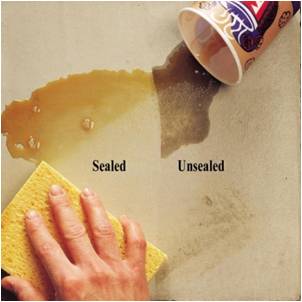
Photo by Brightstone Stone Care
The need for sealing marble in your home or office can be easily determined by following a simple test to determine how absorbent your marble is.
This test can be done with products readily available in most homes or businesses.
Some marble is already sealed at the fabricator and may not need to done based on the results of this test.
Others will indicate a high level of absorbency so you’ll then know steps need to be taken to minimize future impacts to your finish.
This test works for both marble, granite and other natural stone surfaces.
Sealing Marble is Based on its Absorbency
If you’ve recently had marble installed or have purchased an existing home or business which already has marble surfaces, a few easy steps can be taken to determine whether your natural stone was sealed at the time of installation or was installed without sealer or needs to be resealed after extensive use and exposure.
Testing for Water-Based Marble Staining
Here’s what to do to determine if a water-based sealer was applied to your marble or granite or how resistant your marble is to absorbing water-based materials.
- Take about 2 tablespoons of regular tap water and place or your marble or granite
- Let the water sit naturally for 10 to 15 minutes without any exposure to blowing air or heat
- At the end of the time period, wipe up the water with a dry soft cloth
Looking at the where the water was before it wiped up, the stone will either exhibit a darker shade or you will notice no change.
In the instance of no change, then your marble is already sealed and/or your granite will not accept a water-based sealer because granite has low absorption properties.
If you notice a darkening of the marble or granite where the water sat, then your natural stone has not been sealed or it has been a long time since it was sealed and needs to be sealed again.
The results of darkened slab tells you that water-based liquids can soak in, damaging and staining your marble or granite.
Testing for Oil-Based Marble Staining
This same test needs to be conducted for petroleum or oil-based products you may use on a regular basis. To conduct this part of the test, follow these steps:
- Take a small amount of mineral oil and use a cotton ball or something similar to dab it on your marble or granite.
- The mineral oil should sit for the same 10 to 15 minutes as the water test (both can be done at the same time).
- At the end of the prescribed period, wipe up the mineral oil with a soft, clean absorbent cloth.
If the mineral oil leaves no stain, then your marble or granite is not in need of sealing. On the other hand, if a stain is present where the mineral oil was, you will need to seal marble and/or granite with a petroleum-based sealer.
NOTE: When testing with mineral oil, know that mineral oil will evaporate and is not an indication that your marble or granite is damaged but rather that it needs marble sealing. No other oils should be used for this portion of the test.




